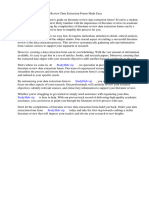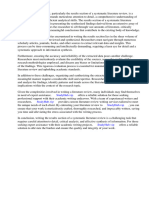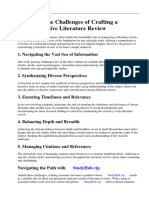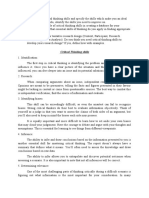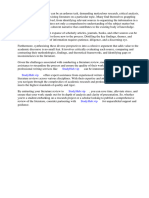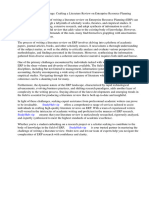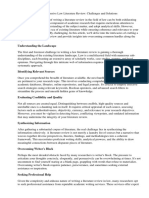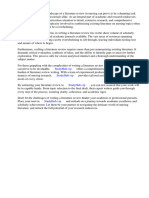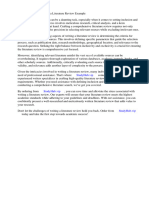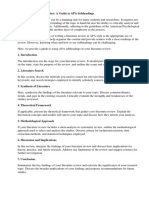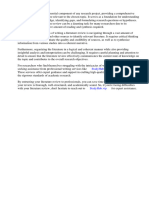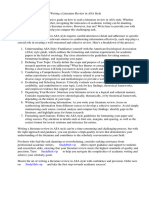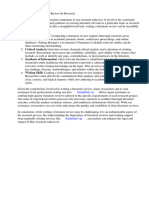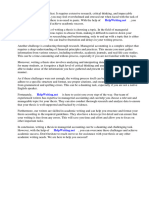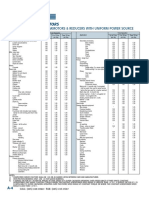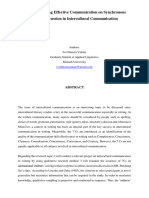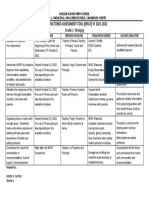Struggling with your literature review data collection form? You're not alone.
Crafting a
comprehensive literature review is no easy feat—it requires meticulous research, critical analysis, and
synthesis of existing literature. And when it comes to data collection forms, the challenges only seem
to multiply.
From selecting the most relevant sources to organizing vast amounts of information, every step of the
literature review process demands careful attention and expertise. And let's not forget about the
daunting task of crafting a cohesive narrative that ties everything together seamlessly.
If you're feeling overwhelmed by the complexities of writing a literature review data collection form,
fear not. Help is at hand. At ⇒ StudyHub.vip ⇔, we specialize in providing expert assistance with
all aspects of academic writing, including literature reviews.
Our team of experienced writers understands the intricacies of literature review data collection
forms. Whether you need help with structuring your form, identifying key themes, or analyzing
data, we've got you covered. With our assistance, you can rest assured that your literature review
will be thorough, well-organized, and backed by credible sources.
Don't let the challenges of writing a literature review data collection form hold you back. Order from
⇒ StudyHub.vip ⇔ today and take the first step towards academic success.
�While the template provides a general structure, you should adapt it to fit the specific requirements
and focus of your literature review. Covidence allows you to create and publish a data extraction
template with text fields, single-choice items, section headings and section subheadings; perform
dual and single reviewer data extraction; review extractions for consensus; and export data extraction
and quality assessment to a CSV with each item in a column and each study in a row. One study
observed that independent data extraction by two authors resulted in fewer errors than data
extraction by a single author followed by verification by a second (Buscemi et al 2006). Use the
PICOT framework to choose data elements in the data extraction form. To ensure the search is as
comprehensive as possible, backwards citation chaining of included studies will be used to identify
any additional studies of relevance. Embedded literature reviews, meanwhile, are part of a larger
piece of writing, such as an essay, thesis, or scholarly article. Disagreements were resolved by
discussion or, if this was unsuccessful, arbitration with DP. As a result, although narrative reviews are
informative, they often include an element of selection bias. RedCap is compliant with HIPAA
regulations, but not 21 CFR Part 11, which describes how records must be kept about access of
patient data. This will include synthesis of study characteristics and, potentially, statistical synthesis
of study findings. What has the literature revealed? (not what do you seek to discuss). Two
reviewers working independently are preferred for accuracy. Covidence allows you to create and
publish a data extraction template with text fields, single-choice items, section headings and section
subheadings; perform dual and single reviewer data extraction; review extractions for consensus; and
export data extraction and quality assessment to a CSV with each item in a column and each study
in a row. Presenting Results Data extraction, sometimes referred to as data collection or data
abstraction, refers to the process of extracting and organizing the information from each included
(relevant) study. New England Journal of Medicine 2011; 364: 852-860. Ask closed-ended questions
(i.e. questions that define a list of permissible responses) as much as possible. We will provide a
descriptive numerical summary of the characteristics of included studies. When data are collated
electronically, all or a subset of them can easily be exported for cleaning, consistency checks and
analysis. However, empirical evidence indicates that the extent to which systematic review authors
explore misconduct varies widely (Elia et al 2016). For example, a statement indicating that, unless
otherwise specified, all data came from the primary reference for each included study would suffice.
Unfortunately, most adverse events are collected non-systematically rather than systematically,
creating a challenge for review authors. Chapter 5: Collecting data 5.5.9 Automating data extraction
in systematic reviews. As a result, it is possible and encouraged to publish abbreviated versions of the
review in other applicable scholarly journals; indeed, engaging in a review update or joining a well-
established review team may be a beneficial way to get involved in the systematic review process.
Fourth, analyze the patterns you noted by considering similarities and differences between sources.
Review authors may need to request missing information from study authors. The following example
outlines what could be included in a data extraction form for a review of effectiveness studies
adapted from the Centre for Reviews and Dissemination 2: General Information Date of extraction
Bibliographic information of the study Name of reviewer Specific Information Reverification of
study eligibility Population characteristics and setting Methodological quality of the study
Interventions Coding format and instructions for coders 1. A close examination of study
characteristics will require detailed tables; for example, to identify differences in characteristics that
were pre-specified as potentially important modifiers of the intervention effects. Necessary Skills
Literature Review: An Overview for Students Defining the Scope Finding the Literature Managing
Your Research Writing the Review. Such investigations should address how the tool will fit into
existing workflows. The amount and types of data you collect, as well as the number of collaborators
who will be extracting it, will dictate which extraction tools are best for your project.
�The literature review surveys scholarly articles, books, and other scholarly sources relevant to a
particular area of research. Regulatory reviews such as those available from the US Food and Drug
Administration or European Medicines Agency provide useful information about trials of drugs,
biologics, and medical devices submitted by manufacturers for marketing approval (Turner 2013).
RedCap is compliant with HIPAA regulations, but not 21 CFR Part 11, which describes how records
must be kept about access of patient data. Other characteristics that are sometimes important include
ethnicity, socio-demographic details (e.g. education level) and the presence of comorbid conditions.
As much as possible, questions should be asked in a way that minimizes subjective interpretation and
judgement to facilitate data comparison and adjudication. Sitemap case study cover letter creative
writing presentation problem solving rewiew prompts websites tips. Relevant data will be extracted
using a data charting form. The selection of outcomes across systematic reviews of the same
condition is also inconsistent (Page et al 2014, Saldanha et al 2014, Saldanha et al 2016, Liu et al
2017). None of the documents specifies how this may be done, for example regarding the number or
types of studies involved. The Merriam-Webster dictionary defines synthesis as something that is
made by combining different things or the composition or combination of parts or elements so as to
form a whole (Synthesis, n.d.). In other words, building a summary table or synthesis matrix
involves taking information from a variety of sources, evaluating that information and forming new
ideas or insights in an original way. A comprehensive literature review helps researchers identify
unanswered questions and make a case for further studies. Ip S, Hadar N, Keefe S, Parkin C, Iovin
R, Balk EM, Lau J. Stage 3: selecting studies The process of selecting studies will consist of two
stages: (1) title and abstract screening and (2) full-text screening. However, there are templates and
guidance available to help in the creation of your forms. Systematic approaches to a successful
literature review. If chosen, the electronic document or paper-and-pencil extraction methods should
only be used for small reviews, as larger sets of articles may become unwieldy. Items of interest We
looked at a variety of items relevant to three categories of interest: the development of data
extraction forms, the piloting of data extraction forms and the data extraction process. Studies of
guidelines aimed at medically qualified professionals. One of the documents makes a vague
suggestion that all reviewers ought to be involved in pilot testing. Space for comments. As a measure
of the magnitude of effect, for dichotomous outcomes the table will usually provide both a relative
measure (e.g. risk ratio or odds ratio) and measures of absolute risk. A few are able to extract study
design and results (e.g. objectives, study duration, participant flow), and two extract risk of bias
information (Marshall et al 2016, Millard et al 2016). A conceptual framework for implementation
fidelity. Tabulation of study characteristics aids the examination and comparison of PICO elements
across studies, facilitates synthesis of these characteristics and grouping of studies for statistical
synthesis. All different means of data collection require data collection forms. MECIR Box 5.4.a
Relevant expectations for conduct of intervention reviews The data collection form is a bridge
between what is reported by the original investigators (e.g. in journal articles, abstracts, personal
correspondence) and what is ultimately reported by the review authors. For example, if after
reaching consensus on the first few studies, the authors note a frequent disagreement for specific
data, then coding instructions may need modification. The research team will meet regularly
throughout the data extraction process to discuss progress and further changes to the data extraction
form will be made as needed in an iterative process. You may start by defining inclusion parameters
(e.g., qualitative vs. quantitative studies, date published, location of study, etc.). You should also
record keywords to search for your topic and build search strings that will help you find sources (e.g.,
exercise AND mental health AND adolescents). The data extraction form should be as long or as
short as necessary and can be coded for computer analysis if desired. The error rate for outcome data
ranged from 8 to 63%. The CONSORT Statement: revised recommendations for improving the
quality of reports of parallel-group randomised trials.
�Data Extraction At least two reviewers should independently extract data to reduce bias and errors.
The selection of outcomes across systematic reviews of the same condition is also inconsistent (Page
et al 2014, Saldanha et al 2014, Saldanha et al 2016, Liu et al 2017). Feak; John M. Swales Doing a
Literature Review by Christopher Hart. This includes, for example, publications on the merits and
downsides of different types of software (word processors, spreadsheets, database or specialised
software) or the use of pencil and paper versus electronic extraction forms. We also excluded
conference abstracts and other documents not published in full. In contrast, less rich studies may
itemise themes with an occasional indicative text extract and tend to summarise findings. Explore
essential techniques and gain valuable knowledge to enhance your data extraction process. Using
such software for all general QES processes ( table 2, item R20), and then harnessing these skills and
tools when specifically under resource pressures, is a sounder strategy. Words8 Pages. Situation
Reflection ( words) Introduction. Ref. Research Questions: Please define the research questions for
your study in the first step. Step 2. Definitions: In general, we use some formal words in our study,
therefore it’s a good idea to provide definitions for these terms to make things clearer. BMC Med
Res Methodol. 2017;17:152. Gotzsche PC, Hrobjartsson A, Maric K, Tendal B. CONSORT 2010
explanation and elaboration: updated guidelines for reporting parallel group randomised trials.
Anticipate what the data summary table will need to include. If you want to post about it on your
blog or social media, all we ask is that you reference this page as your source. This makes their
development, pilot testing and application a crucial part of the systematic reviews process.
Extracting data from figures with software was faster, with higher interrater reliability than manual
extraction. For the introduction (and discussion) of a research paper, masters thesis or dissertation 3.
The tables included information about authors, country, purpose, study design, setting, sample
characteristics, sampling technique, method of. If articles required translation into another language
to enable data collection, report how these articles were translated (for example, by asking a native
speaker or by using software programs). Sitemap case study creative writing presentation problem
solving rewiew prompts websites tips. If you are conducting an analytical review with a meta-
analysis to compare data outcomes from several clinical trials you may wish to computerize the data
collection and analysis processes. None of the documents specifies how this may be done, for
example regarding the number or types of studies involved. Cherry-picking by trialists and meta-
analysts can drive conclusions about intervention efficacy. This may be sufficient in areas with
consistent and widely understood terminology that matches the PICO for each synthesis. The state
of science relevant to automating data extraction is summarized here (Jonnalagadda et al 2015).
Disagreements were resolved by discussion or, if this was unsuccessful, arbitration with DP. A
literature review gives a high-level overview of research, a broad synopsis of what has previously
been done and by whom, highlights what sections of study tell us about a topic, identifies gaps and
conflicts in the area. SLRs may be quantitative (by only reviewing quantitative studies), qualitative
(by only reviewing qualitative studies), or mixed methods (by reviewing both quantitative and
qualitative studies). It is important to collect the sample size relevant to each result, although this is
not always obvious. Bias due to selective inclusion and reporting of outcomes and analyses in
systematic reviews of randomised trials of healthcare interventions.
�For example, in a review of aspirin and gastrointestinal haemorrhage, some trials simply reported
gastrointestinal bleeds, while others reported specific categories of bleeding, such as haematemesis,
melaena, and proctorrhagia (Derry and Loke 2000). Always cite your sources correctly and
paraphrase ideas in your own words while maintaining the original meaning. Stage 1: identifying the
research questions The first stage of a scoping review is to develop research questions which are
informed by the purpose and objectives of the scoping review. 31 Based on the aforementioned
objectives of this scoping review, we have formulated six research questions. It is not just a
descriptive list of the material available, or a set of summaries. Question 6: do ED treatment
experiences differ across ethnic groups. So, don’t shy away from existing research that takes an
opposing view to yours. Theories may be unearthed within the topic search or be already known to
team members, fro example, Theory of Planned Behaviour. 29 Options for managing the quantity and
quality of studies and data emerge during the scoping (see above). Limitations of our method are the
scoping nature of the review and that we did not analyse internal documents of health technology
agencies. Two reviewers working independently are preferred for accuracy. In contrast, less rich
studies may itemise themes with an occasional indicative text extract and tend to summarise findings.
Lastly, authors of reporting guidelines for systematic reviews of various types can use our results to
consider elements worth including. We describe this as intervention integrity; related terms include
adherence, compliance and fidelity (Carroll et al 2007). Furthermore, in the end, you have to map
your results as per your research questions. New England Journal of Medicine 2011; 364: 852-860.
However, despite similar and in some cases increased prevalence of disordered eating and EDs
among minority ethnic groups, there appear to be disparities when it comes to ED diagnosis and
treatment. It is recommended that you pilot your data extraction tool, especially if you will code
your data, to determine if fields should be added or clarified, or if the review team needs guidance
in collecting and coding data. This template is for the write-up of the actual literature review chapter,
whereas the catalog is for use during the literature sourcing and sorting phase. Funding: JPTH is a
member of the National Institute for Health Research (NIHR) Biomedical Research Centre at
University Hospitals Bristol NHS Foundation Trust and the University of Bristol. Process evaluations
can be a useful source of factors that potentially influence the effectiveness of an intervention. 5.3.5
Outcome s An outcome is an event or a measurement value observed or recorded for a particular
person or intervention unit in a study during or following an intervention, and that is used to assess
the efficacy and safety of the studied intervention (Meinert 2012). Since many HTA agencies
publish detailed documents on many other methodological aspects such as search screening methods,
risk of bias assessments or evidence grading methods, it would seem reasonable to provide more
information on data extraction methods. The search strategy for our database search was pragmatic
for reasons stated in the methods and may have missed some relevant articles. These should be
extracted if they provide potentially useful information (see MECIR Box 5.3.c ). Details of
recalculation are provided in Section 5.6. Further considerations for dealing with missing data are
discussed in Chapter 10, Section 10.12. MECIR Box 5.3.c Relevant expectations for conduct of
intervention reviews 5.3.7 Other information to collect We recommend that review authors collect
the key conclusions of the included study as reported by its authors. Washington, DC: The National
Academies Press; 2011. For instance, when a generic inverse variance meta-analysis is conducted,
standard errors are of interest, whereas in other cases standard deviations may be preferably
extracted. Many of these terminologies are used interchangeably in the literature, although some are
technically different. For example, recommendations in the new Cochrane Handbook are based on
Cochrane’s Methodological Expectations for Cochrane Intervention Reviews Standards (MECIR)
which make a subtle differentiation between mandatory and highly desirable recommendations. To
write a strong embedded literature review, you should approach your research systematically. The
importance of a rigorous data extraction process is not restricted to outcome data. Disclaimer The
views expressed are those of the authors and not necessarily those of the NIHR or the Department of
Health and Social Care. The studies in a table can also be grouped in terms of applied intervention
type, type of outcome measure, the type of participants, the study design etc.
�This may be particularly problematic for less experienced reviewers. This included specific
recommendations on the sample of studies that should be used to pilot the data extraction form or
the experience or expertise of the reviewers that should be involved. Decisions on relevance are
challenging—precautions for swine influenza may inform precautions for bird influenza. 28 A
smoking ban may operate similarly to seat belt legislation, etc. For example, Al-Marzouki and
colleagues concluded that a trial report was fabricated or falsified on the basis of highly unlikely
baseline differences between two randomized groups (Al-Marzouki et al 2005). Non-systematic
collection methods tend to underestimate how frequently an adverse event occurs. A service of the
National Library of Medicine, National Institutes of Health. Data extraction form and quality
assessment methods used - Does therapeutic writing help people with long-term conditions. Need of
systemic review and meta-analysis: There are several reasons for performing a systematic review and
meta-analysis: It may assist in resolving discrepancies in results published by individual studies that
may include bias or errors. It’s preferable to list them in a tabular style. Step 3. Keywords: Make a
list of the keywords you’ll use to search in the databases. Standardizing and sharing data collection
tools as well as data management systems among review authors working in similar topic areas can
streamline systematic review production. The present scoping review aims to examine the extent,
range and nature of research activity into disordered eating and EDs in the UK, Canada, Australia
and New Zealand providing a comprehensive overview of the existing literature. Evidence level 1
(Table 3.1). RCTs, controlled clinical trials, controlled before-and-after studies, interrupted time
series from 1966 to 1998 (levels 2, 3, 4). Innovations in data collection, management, and archiving
for systematic reviews. When changes are made to the form or coding instructions, it may be
necessary to return to reports that have already undergone data extraction. Portion, package or
tableware size for changing selection and consumption of food, alcohol and tobacco. In fact, I just
started doing so when I was writing the confirmation report. Other more detailed guidelines and
criteria, such as the Consolidated Standards of Reporting Trials (CONSORT), as well as articles with
recommendations for improving quality in RCTs and meta-analyses for psychological intervention,
are available (4). Better ways to question patients about adverse medical events: a randomized,
controlled trial. A manual or guide may help your team establish standards. Cochrane Database of
Systematic Reviews 2014; 1: CD008963. In both stand-alone and embedded historiographies, you
must support your arguments and analyses with examples from the sources. Choose the pieces of
information you want to collect from each study. Within the USA, studies have explored the
identification, prevalence, presentation, risk factors and treatment of EDs among minority racial and
ethnic groups. In either case, adverse events may be selectively reported based on their severity, and
whether the participant suspected that the effect may have been caused by the intervention, which
could lead to bias in the available data. British Journal of Ophthalmology 2014; 98: 464-468. BMJ
disclaims all liability and responsibility arising from any reliance placed on the content. Sometimes
the required data may be obtained only indirectly, and the relevant results may not be obvious. A
review of a clearly formulated question that uses systematic and explicit methods to identify, select,
and critically appraise relevant research, and to collect and analyse data from the studies that are
included in the review. In some cases, study investigators may find it more convenient to provide
IPD rather than conduct additional analyses to obtain the specific statistics requested. The headings
of your spreadsheet are where you can make this your own.
�This synthesis should encompass the characteristics of the interventions and comparators in included
studies, the populations and settings in which the interventions were evaluated, the outcomes
assessed, and the strengths and weaknesses of the body of evidence. Consult your library subject
guide to review databases appropriate for your topic. It is assumed that by mentioning a previous
work in the field of study, that the author has read, evaluated, and assimilated that work into the
work at hand. The exact procedure may vary according to your resource capacity. Defining the
process to literature searching in systematic reviews: a literature review of guidance and supporting
studies. None of the documents specifies how this may be done, for example regarding the number
or types of studies involved. Selecting and appraising studies for a systematic review. Walden
University Academic Guides Writing Center Common Assignments Literature Review Matrix.
Studies of guidelines aimed at medically qualified professionals. Additionally Cornell University
Library have a comprehensive list of data extraction tools on their LibGuide. Thus, discussion among
the authors is a sensible first step. Resources for students and trainees some key resources are
highlighted in the next few pages researchers around the world have found these useful its worth a
look and it might save you a lot of time. Rapid reviews summarise information from multiple
research studies to produce evidence for 'the public, researchers, policymakers and funders in a
systematic, resource-efficient manner'.16 Involvement of knowledge users is critical.3 Given time
constraints, individual knowledge users could be asked only to feedback on very specific. To
accompany tabular and visual summaries, we will also provide a qualitative narrative summary of the
data and how it relates to our research questions. In this case we considered both these types of
recommendations as positive in our classification scheme. This is crucial considering the identified
need for more research exploring racial and ethnic differences in EDs outside of the USA. 24 Given
the well-documented racial and ethnic health disparities in the diagnosis and treatment of EDs 16
and mental health conditions more broadly, 27 a special focus will be placed on studies which have
reported on the prevalence of disordered eating and EDs, access to care and treatment experiences
among minority ethnic groups. Like other literature reviews, historiographies can be embedded or
stand-alone. FAQs: Literature Review Template What format is the template (doc, pdf, ppt, etc.). The
literature review chapter template is provided as a Google Doc. Three examples of a data extraction
form are below: Data Extraction Form Example (suitable for small-scale literature review of a few
dozen studies) This example was used to gather data for a poster reporting a literature review of
studies of interventions to increase Emergency Department throughput. Walden Departments,
Centers, and Resources Departments Academic Residencies Academic Skills Center Career Services
Customer Care Team Disability Services Field Experience Literature review table template Military
Services Office of Student Experiential Learning Services Student Affairs Student Success Advising
Writing Center. A systematic review review protocol organization city country. Several studies have
shown that data extraction errors are frequent in systematic reviews, especially regarding outcome
data. Moore GF, Audrey S, Barker M, Bond L, Bonell C, Hardeman W, Moore L, O'Cathain A,
Tinati T, Wight D, Baird J. If any decision rules were used to select data from multiple reports
corresponding to a study, and any steps were taken to resolve inconsistencies across reports, report
the rules and steps used. The purpose of this question is to assess what is currently known regarding
the treatment experiences of minority ethnic patients. New York (NY): Russell Sage Foundation;
1994. p. 139-162. Page MJ, McKenzie JE, Kirkham J, Dwan K, Kramer S, Green S, Forbes A.
Baudard M, Yavchitz A, Ravaud P, Perrodeau E, Boutron I. We also planned to include the newly
founded Asia-Pacific HTA network (HTAsiaLink), but the webpage had not yet been launched
during our research period. Conducting systematic reviews of intervention questions II: Relevance
screening, data extraction, assessing risk of bias, presenting the results and interpreting the findings.
Development, testing and use of data extraction forms in systematic Methods.
�Authors will need to assess whether the measurement methods or tools used within each study
provide an appropriate assessment of the domains ( Chapter 3, Section 3.2.4 ). A next step is to
group each measure into the pre-specified time points. Detailed information should be collected to
facilitate assessment of the risk of bias in each included study. For example, you may have a team of
10 extractors in 5 pairs of 2 extracting data from chunks of the included material, if managing a
large corpus. The tables included information about authors, country, purpose, study design, setting,
sample characteristics, sampling technique, method of. These include information about the main
outcomes, the type and number of studies included, the estimates (both relative and absolute) of the
effect or association, and important comments about the review, all written in a plain-language
summary so that it’s easily interpreted. Resources for students and trainees some key resources are
highlighted in the next few pages researchers around the world have found these useful its worth a
look and it might save you a lot of time. As the name implies, systematic reviews usually include a
thorough and comprehensive plan and search strategy derived a priori to minimise bias by finding,
evaluating, and synthesising all related studies on a given subject. Studies conducted in non-
Western, low-income or middle-income countries will not be included in this review. However, for
any synthesis that underpins practice recommendations 39 assessment of included studies is integral
to the credibility of findings. Agreement of coded items before reaching consensus can be
quantified, for example using kappa statistics (Orwin 1994), although this is not routinely done in
Cochrane Reviews. Synthesizing Qualitative and Quantitative Health Evidence. The PRISMA or
Meta-analysis must be used to write up the systematic study and meta-analysis. To print the
document completely, please, download it. CRD’s guidance for undertaking reviews in health care.
Unfortunately, most adverse events are collected non-systematically rather than systematically,
creating a challenge for review authors. Arguably, some items in our analysis have theoretical rather
than empirical foundations. Outcomes used in trials and in systematic reviews of the same condition
have limited overlap (Saldanha et al 2017a, Saldanha et al 2017b). Extraction templates and
approaches should be determined by the needs of the specific review. View the Data Extraction
chapter and associated appendix for the type of review you are conducting. Consequently, the
findings of a systematic review depend critically on decisions relating to which data from these
studies are presented and analysed. In the literature review, the persons involved in compiling the
portfolios need to be involved in learning of these portfolios. This may be sufficient in areas with
consistent and widely understood terminology that matches the PICO for each synthesis. For
literature reviews to be reliable and independently repeatable, the process of systematic literature
review must be reported in sufficient detail (Okoli and Schabram 2010). Frequency of data
extraction errors and methods to increase data extraction quality: a methodological review. For
example, numerical data pertaining to important demographic, efficacy, and safety variables are
placed within the main text in tables and figures. Consider using transition phrases like the
following, or borrow phrasing that you like from other articles. (It's not plagiarism to use common
phrases.). Using regulatory reviews from the US Food and Drug Administration as an example, drug
approval packages are available on the agency’s website for drugs approved since 1997 (Turner
2013); for drugs approved before 1997, information must be requested through a freedom of
information request. Primary research entails personally asking study the subject’s questions and
requires approval. BMC Med Res Methodol. 2018;18:85. Download references Acknowledgments
We thank information specialist Simone Hass for peer reviewing the search strategy and conducting
searches. If results were obtained from multiple sources (such as journal article, study register entry,
clinical study report, correspondence with authors), report the source of the data.













